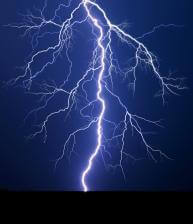What Causes Lightning Bolts?
Ask Science explains the mechanics of lightning and thunder.

See also: Dogs and Thunderstorms
Sponsor: This episode is brought to you by GoDaddy.com. GoDaddy.com offers everything you need to make a name for yourself on the Web, including domain name registration, website hosting, and more. Get 20% off your hosting plan purchase atGoDaddy.com by using the code hostpod62 at checkout.
Fast as Lightning
While we don’t understand everything about lightning, here are some things we do know. Lightning is like a giant spark of static electricity. Particles of ice smash into one another inside of storm clouds, breaking apart and picking up electrostatic charges. The lighter, positively charged particles gather near the top of the clouds, while negatively charged particles gather near the base.
What happens next depends on lots of complicated factors. One possibility is that once the voltage is high enough, an electrostatic discharge occurs between the two regions of the same cloud, forming what is called intra-cloud lightning.
Sometimes, the discharge can occur between the positively charged region of one cloud, and the negatively charged region of another. This is called inter-cloud lightning.
The kind of lightning most of us are familiar with is called cloud-to-ground lightning. Though a more accurate name would be cloud-meets-the-ground-halfway-lightning, but that isn’t anywhere near as catchy.
In cloud-to-ground lightning, the electrostatic charge occurs between the cloud and the ground. It’s a rather complicated process, but it starts with electrical “leaders” forking out from the cloud towards the ground in random, jagged steps. Once these steps get close enough to the ground, electrical “streamers” start to extend from objects on the ground towards the charge coming from the cloud.
Once the leader and streamer connect, a massive electrical charge flows from the cloud into the ground, producing the bright flash called the “return stroke” which we most commonly associate with lightning. The rest of the process is visible as well, but it happens so fast that it’s difficult to see.
One interesting fact is that while the charges flow from the cloud to the ground in the return stroke, the flow starts at the bottom and drains out from bottom to top. If you held a container of water up in the air and poked a hole in the bottom, the water would flow out the same way that electrical charge travels in the return stroke.
Thunder, Thunder, Thundercats!
As the electrical discharge occurs, the air along the lightning’s path is heated to extremely high temperatures, around three times the temperature of the sun. This causes the air around the lightning strike to compress suddenly, resulting in a large shockwave. This shockwave travels outward from the source, resulting in the sound that we call thunder.
Calculating Distance to Lightning
You’ve probably heard that you can estimate how many miles away a lightning strike happens by counting the seconds between the lightning and the thunder, and dividing by 5.
The reason that works is because the light and the sound from a lightning strike start out at just about the same time. However, while the flash of light reaches our eyes almost instantly, the sound of thunder travels only about one-fifth of a mile every second, or one mile in 5 seconds.
See also: How to Find the Distance to Thunderstorms and Fireworks
Conclusion
So now you know a little of the science behind thunder and lightning. While knowledge is power, keep in mind that there is no safe place out of doors during a thunderstorm. If you hear thunder, get to an enclosed building or car as soon as possible. Lots of other tips for lightning safety can be found on the NOAA’s Lightning Safety website.
If you liked today’s episode, you can become a fan of Ask Science on Facebook or follow me on Twitter, where I’m @QDTeinstein. If you have a question that you’d like to see on a future episode, send me an email at everydayeinstein@quickanddirtytips.comcreate new email.
Lightning image courtesy of Shutterstock.






